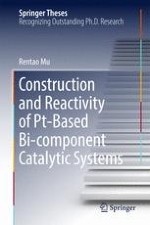2017 | Buch
Über dieses Buch
In this thesis, the author outlines the construction of active structure and modulation of catalytic reactivity of Pt-based bi-component catalysts, from the model systems to real supported catalysts. The thesis investigates the promotion effect of the second components on catalytic performance of Pt catalysts, and presents the reversible generation of the “sandwich-like” structure of Pt-Ni catalysts, containing both surface NiO1-X and subsurface Ni by alternating redox treatments at medium temperature. With the aid of single layer graphene, the dynamic process of chemical reactions occurring on the Pt(111) surface can be visualized using in-situ LEEM and DUV-PEEM techniques, the results of which are included here. The author reveals that the graphene layer exhibits a strong confinement effect on the chemistry of molecules underneath and the intercalated CO can desorb from the Pt surface around room temperature and in UHV, which may promote the CO oxidation confined under graphene.
Anzeige
